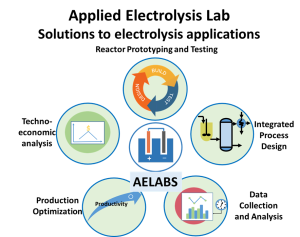William DeSisto
|
|
Professor
Office: 305 Jenness Hall Phone: 207.581.2291 |

At the University of Maine Applied Electrolysis Laboratory, AEL, we are developing solutions to electrolysis applications. We have developed and tested electrolysis reactor prototypes for the co-production of hydrogen and chlorine. This includes mass and energy balances. We have prepared techno-economic analysis of integrated processes for private equity firms. We are developing a process logic controller for data collection, analysis and process control.
Our facility is located within the Chemical and Biomedical Engineering Department at the University of Maine, in Orono (UMaine). Our team consists of undergraduate and graduate students. We have students with backgrounds in chemical, biomedical and electrical engineering.
Projects
Rethinking Wastewater
We have an active collaboration with Maine Manufacturing Partners https://mmph2.com/ to advance technology for wastewater reuse. North America produces 67 billion cubic meters of wastewater annually. Using wastewater for the co-production of hydrogen and chlorine from electrolysis presents technological challenges. We are taking steps to address the critical technological challenges through a unique reactor design and power delivery. We are also collaborating with several wastewater treatment facilities in Maine.
Hypochlorous Acid Production
Through funding from the Economic Development Agency we are focused on locally-sourced disinfectant production. The pandemic exposed significant weakness in critical infrastructure and supply. The list is long. One element is disinfectant supply. Local-sourcing of disinfectant creates a robust supply chain. Electrolysis of salt water to produce chlorine is a well-established technology. Depending on the conditions, electrolysis can produce either hypochlorous acid and/or bleach.
There are significant differences between hypochlorous acid and bleach. Hypochlorous acid is produced in the body as part of the response to infection. For some applications, hypochlorous acid is up to 100 times more effective at disinfection than bleach. Because it is pH neutral and used at low concentrations, hypochlorous acid is generally considered non-toxic.
The pandemic created new opportunities for hypochlorous acid in the disinfectant market. We are exploring the technology behind hypochlorous acid production. We are assessing market opportunities for hypochlorous acid. Finally, where are the opportunities to replace out-sourced disinfectants with locally-sourced ones?
Media Links
Hydrogen Production
Hydrogen is a co-product of saltwater electrolysis used to generate chlorine often in a simple, robust, undivided cell. The undivided cell can keep costs lower. These electrolyzers currently vent hydrogen as a waste stream.
In collaboration with Manufacturing Partners (MMP) efficient hydrogen separation has been demonstrated using lower quality feed water, for example, clarified but untreated wastewater.
Generation of resources from wastewater
Raw material generation from wastewater can create building blocks for chemical production. Chlorine is a powerful disinfectant. Hydrogen can be used for energy or in chemical applications. For example, reactions with nitrogen and carbon dioxide can produce ammonia and methanol. Hydrogen can be used to destroy recalcitrant toxins. There are abundant opportunities for using wastewater to generate resources.
Other Interests
I maintain several other interests outside of research. These include youth sports coach (basketball and baseball), Scouting leader, and all sorts of outdoor activities like hiking, canoeing and camping.
Selected Publications

